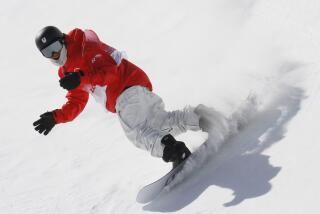When Cold Damage Is Mainly Skin Deep
- Share via
Journeys to cold weather climes can invigorate the soul but damage the skin. Sunburn, windburn, chapped lips, dry skin and frostbite are all potential problems, whether travelers are skiing, snowmobiling, mountain climbing, camping or just walking in the crisp air.
Increasing the sun protection factor (SPF) of sunscreen is a smart first step, said Dr. Kathleen Adair, a Santa Monica dermatologist. “Sunburn is a big concern,” she said. “And you get more sun at higher altitudes. The snow reflects, and you increase ultraviolet exposure with altitude.”
Levels of ultraviolet exposure increase 2% with every 1,000-foot increase in altitude, according to the U.S. Environmental Protection Agency.
While the proper SPF varies according to skin type, Adair said the best general rule is to “wear a higher number than you normally would.” She often suggests an SPF of at least 30.
To prevent windburn, “physically cover your face,” she said. Mufflers and ski masks are good bets.
To prevent chapped lips, keep reapplying lip balm, ideally every hour, Adair recommended. It’s important to choose balm with sunscreen, she said. “People don’t think of their lips getting sunburned. But you can burn the lips and you can get skin cancer on the lip.”
While sunburn, windburn and chapped lips usually are easy to self-treat, frostbite generally is not. Most cases demand medical attention, said Dr. Ken Zafren, an Anchorage, Alaska, emergency medicine specialist on the board of directors for the Wilderness Medical Society, an organization devoted to wilderness medicine.
“Frostbite is true freezing of body tissue,” he said. “You lose enough heat to get ice formation in the tissue.”
The most commonly affected sites are the nose, ears and extremities, “especially the fingers and toes,” Zafren said.
Even covered body parts can become frostbitten. “A sensation of numbness is usually the first symptom,” he said. “The area is cold to the touch. People often complain they feel clumsy, like a block of wood. The area looks white and hard.”
“Warm it with warm water,” Zafren advised, suggesting this measure only if travelers are sure the area won’t refreeze later, before they can get to medical help. The water temperature should be about 98 to 106 degrees Fahrenheit, about body temperature or above, he said.
Seek medical help, even if the area looks better once warmed. “It can look deceptively benign once thawed,” Zafren said. And it can take days or weeks before the extent of tissue damage is known.
Proper attire can help minimize many cold weather skin problems. Modern thermal underwear materials are more effective in maintaining body heat than older styles. Today’s thermals are usually made of materials that “wick moisture from the inner layer to the outer and help you to stay warm,” said Rob Henderson, manager of the R.E.I. camping supply store in Northridge.
Choose the style best suited for the sport, he said. Lightweight thermals are ideal for such activities as cross-country skiing, he said, while mid-weight is best for downhill skiing. Henderson advises expedition weight for camping at zero-degree temperatures.
Face masks of neoprene, a synthetic rubber used in wetsuits, as well as ski masks, can help ward off chapped lips and windburn.
Instead of bulky ski gloves, Henderson suggests wearing an inner liner and an outer glove, “not necessarily a ski glove.”
“Keep equipment dry,” advised Don Taylor, an emergency medical technician at Deer Valley Resort, Park City, Utah. When the face and hands become wet, that increases the chance of frostbite, he said.
Paying attention to the inside environment can help skin feel better too. Try to find hotels or motels with humidifiers, Adair recommended. If that’s not possible, she has a do-it-yourself suggestion.
“Take a bath towel and get it soaking wet. Hang it over the shower [rod]. It will humidify the room somewhat.”
The Healthy Traveler appears the second and fourth week of every month.
More to Read
Sign up for The Wild
We’ll help you find the best places to hike, bike and run, as well as the perfect silent spots for meditation and yoga.
You may occasionally receive promotional content from the Los Angeles Times.






